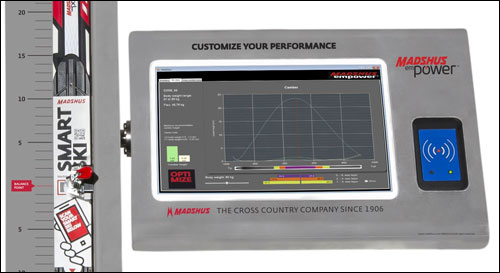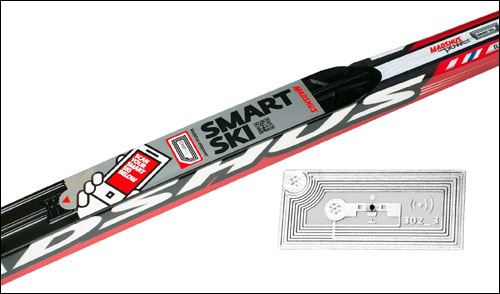Nordic skis vary according to a user’s size and the conditions in which he or she is skiing. To help stores and customers identify the correct skis and ensure that they are being used and waxed properly, Norwegian-based ski manufacturer Madshus has begun embedding passive Near Field Communication (NFC) RFID tags into each ski within its Champion series (the Hypersonic, Nanosonic and Redline models), and is storing data on the company’s server, linked to the tags’ ID numbers, throughout the manufacturing process. The RFID feature, known as empower, is expected to be available to retailers and consumers this coming fall, in time for the 2014-15 skiing season.

For Madshus, the use of passive high-frequency (HF) RFID tags, compliant with the ISO 15693 standard, will benefit its ski factory by helping it track which processes are completed on every product. But the tag has another primary purpose: to help stores and customers ensure that the proper pair of skis is sold to each customer, by identifying its type and how it was manufactured, and to provide instructions regarding how to wax that specific pair of skis. Customers will be able to access data about each ski prior to making a purchase, by utilizing an NFC-compliant RFID reader built into a mobile phone, or through Madshus’ tablet-based retail displays with built-in readers.
Beginning in fall 2014, customers with NFC-enabled phones will be able to download the MyMadshus application from the company’s website. They can then use the app to access waxing and performance information regarding their specific skis for particular skiing conditions, in addition to weather forecasts and training information.
Madshus is now embedding the NFC tags in its Champion series skis (the left and right ski each has its own tag), according to Chris McCullough, the global brand manager of K2 Outdoor, a division of K2 Sports, which is also Madshus’ parent company. Madshus’ Norwegian factory has installed six RFID interrogators, so that every ski’s tag is read at each processing point, including the application of layers of foam or other materials and the completion of finish work, before the skis are shipped to retailers.
Nordic skis must be fitted specifically to an individual athlete in order to deliver the best performance, based on that person’s weight and size, along with the conditions in which he or she skis. Skis vary based on internal properties that affect flexibility, such as the type and thickness of materials in the core, as well as the ski’s camber line (curved portion). Currently, when a customer visits a ski store, employees must take into account the buyer’s weight and attempt to identify the best kind of ski for that individual. They must then perform flexibility tests by putting pressure on the skis specific to that customer’s weight, and then determining, based on that flexibility, the part of the ski (known as the wax pocket) to which the wax should be applied in order to ensure the optimal performance. With NFC technology, Madshus hopes to make this process much easier.
McCullough declines to indicate the make and model of the tags or readers being used. However, he says, at the Madshus factory, a fixed reader captures the tag’s unique ID number at each process point and links that ID with the process completed, storing that data in its software. In this way, the company has an electronic view into work-in-progress, and a record proving any given ski’s quality and properties. Factory workers also employ handheld readers for situations in which a fixed interrogator is impractical.
Once a ski is shipped to a retailer, the store’s personnel will be able to use the NFC-enabled tablet to access data about it on Madshus’ server. When a customer comes looking for specific skis, based on his or her size and performance requirements, the sales staff can read the tags of each pair in inventory and thereby determine which one is right for that individual. They can also view a graph indicating the size and location of that particular pair’s proper wax pocket, based on the customer’s size.
Upon reaching the ski slope with a quiver of skis, the consumer can use his NFC-enabled mobile phone to read each ski’s tag, thereby launching the MyMadshus app, and input the slope conditions for that day, such as the temperature or snow type. The app will then determine which of his skis are best suited for the performance he seeks during that visit. The phone can also display the wax pockets of any skis he may be waxing.
Although the company is formally unveiling the technology this week at the Outdoor Retailer Winter Market trade show, the products and access to data on the server will not be available to retailers until this fall. At that time, the company reports, the app will also be released.
The RFID technology, McCullough says, not only ensures that the right individual is matched with the correct skis, and can thus care for them appropriately, but “it also keeps us accountable,” since the data serves as proof of how each ski was manufactured. “This makes performance better across the board.”



